#sekishin okimitsu
Explore tagged Tumblr posts
Text


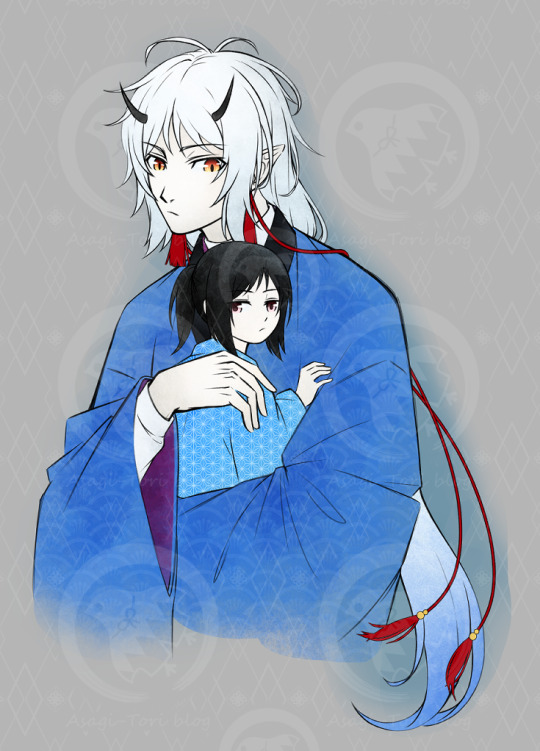
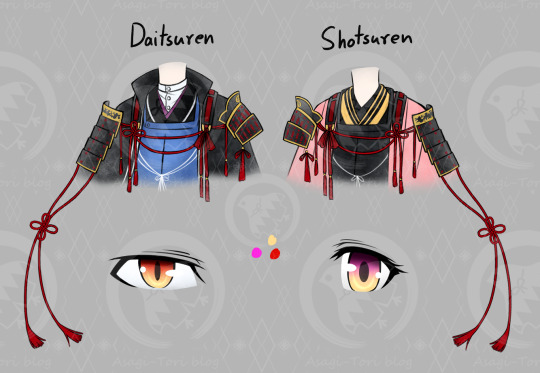
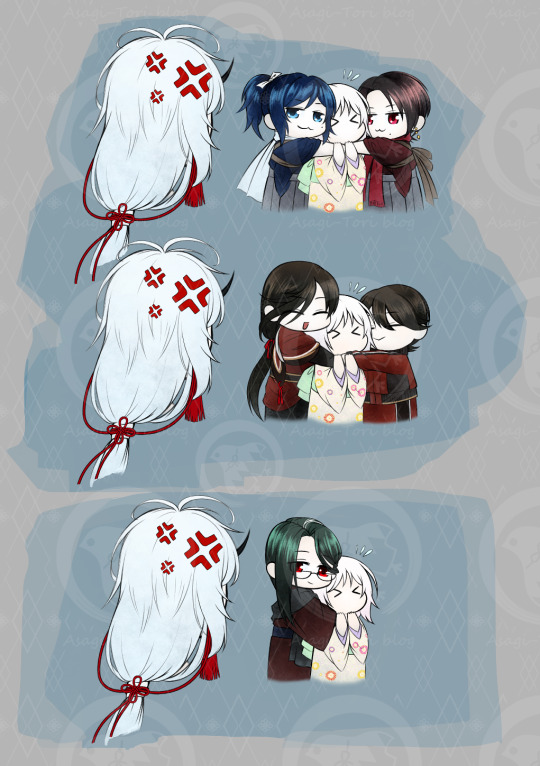
Introducing my Touken Ranbu OC Daitsuren (大通連) Nagumo Kaoru's sword!
WWWOOOOOOOOOOO I finally got it done! ❤
I wanted him to look like both Kaoru and Kazuya (Kaoru and Chizuru's grandfather) since they were his most prominent masters. I made him have a more Oni-like appearance since Kaoru saw himself as more Oni than human while Chizuru saw herself as more human.
I redesigned the armor of Shotsuren to mirror Daitsuren. I also wanted to make clear that both swords have two-toned eyes. Daitsuren has eyes red eyes that fade to yellow. While Shotsuren has pink eyes that fade to yellow. I'm thinking of changing the patterns on the internal affairs outfit.
I also imagine the Okita swords would constantly troll Daitsuren by getting all flirty with Shotsuren when he's around as payback for Souji. Also, the Shinsengumi swords love Shotsuren and some of the swords that also have beef with Kaoru also troll Daitsuren.
#hakuoki#hakuouki#薄桜鬼#touken ranbu#刀剣乱舞#hakuouki x touken ranbu#touken ranbu oc#Daitsuren#shotsuren#小通連#大通連#sekishin okimitsu#izuminokami kanesada#horikawa kunihiro#nagumo kaoru#yamatonokami yasusada#kashuu kiyomitsu#my art
54 notes
·
View notes
Text
Story about Sannan’s sword
Notes: I was provided the original Japanese version by @kumoriyami-xiuzhen. It is honestly my favorite short story about Sannan out of all the three I have translated so far, so, please enjoy.
Sekishin Okimitsu by a person from Banshuu
January, Bunkyuu 3 (1863)
Everyone in Shiekan, which was headed by Kondou Isami, had decided that they would go to Tokyo and join the Roshigumi. They only had a short time until they had to leave to Tokyo so the days of everyone were busy with announcing the separation to acquaintances and arranging their personal baggage. During that time, there was only one person that still remained in an unpeopled Shiekan during the evening. That was Sannan Keisuke.
Sannan first visited Shiekan three years ago, during Manen 1 (1860). Back then, when Kondou Isami received the certificate of mastery of Tensai Rishinryuu and became the young teacher of Shiekan, the dojo was a small one and besides, Hijikata Toshizo, Okita Souji, Inoue Genzaburou, only has a small number of disciples. Sannan as a disciple of the Onoha Ittoryuu fought with Kondou in a battle between schools and lost, and as he was impressed by the strength of the Tensai Rishinryuu, he joined the school. Since then, he had lodged in Shiekan and in a short time, started to study the art of Tensai Rishinryuu. Soon as Kondou’s right hand man, he was entrusted with going to teach in the Tama region.
Sannan was sitting alone in the dojo of Shiekan, properly going through the maintainance his beloved sword.
The first step of this maintenance was to start with cleaning all the oil coating the blade so that it would not rust. Firstly, he used wiping paper to clean up all the oil on the blade. When that process failed to remove all the old oil, he put power on the blade and then wiped again with a wiping paper. He properly wiped from the base of the metal collar to the tip and kept on repeating it so finally the old oil sticking on the blade was cleanly removed.
Then, he carefully checked for any rust or chip on the naked blade and then very thoroughly coated the blade with clove oil. Because the oil coating this blade had deteriorated, he had to maintain the sword by replacing the oil multiple times throughout a year.
For this work, Sannan had to slowly replaced the oil on his sword.
“Huh? The only person left is Sannan-san?”
From the door of the dojo, the unique voice of Okita sounded out.
“That’s right. It is because Nagakura and the other guys went out for drinking; Kondou-san and Hijikata-kun and Inoue-san went out to Tama for some greetings…though I heard that Okita-kun also came along.”
“No, I have no part in that kind of greeting.”
“Is that so? Okita-kun also has family, right? Is that okay?”
“If I show up, my elder sister will definitely oppose, so I think it is better for me not to go. In other terms, because I don’t have any one to greet, I came back alone. Because I am taking care of the dojo, I think that it is better that I greet Sannan-san and pack my baggage.”
So according to what he said, Okita went to the dojo and reached Sannan’s side. In response to Okita, Sannan gave him a slightly lonely smile and answered.
“What a coincidence, actually, I also do not have any acquaintance to greet.”
Looking at Sannan’s face, Okita’s interested eyes glittered.
“Is that so… Even though I cannot see that, if Sannan-san say so, it must be the case. So, how is your preparation for going to Kyo going?”
“The baggage that I am bringing along is only this sword. Because of that, as the maintenance was done, I am already done with the preparation.”
Moving his gaze to the sword lying on the tatami mat in front of Sannan, Okita became interested and looked at the sword.
“Sekishin Okimitsu…was the name, right? Not a famous name, isn’t it? Do you have any emotional attachment to it?”
“This sword… is unique, I brought it from my hometown, Sendai, where I was born. This sword was passed down in my family for generations and when I received this sword, I was told to hold this sword and hit with a true heart (Sekishin means true heart). Certainly, don’t you think that is a suitable path?”
“I do not understand what true heart means for Sannan-san but… Being able to kill your opponent and keep your own life is enough, isn’t it?”
“Haha… That answer is very characteristic of Okita-kun.”
“Is that so… Well, it is fine. So, I also should do the maintenance for my sword. I will bring it here so please just keep on staying in the dojo like this.”
While shrugging his shoulder, Okita also turned his back on Sannan and quickly left the dojo.
In a dojo resounded with those footsteps, Sannan thought.
About abandoning his house in Sendai, leaving his clan to travel alone.
Back then, his only baggage was also Sekishin Okimitsu.
After that, while joining a dojo and living in Edo… This sword was also his only constant companion.
Sannan said gently to his beloved sword lying on top of the tatami.
“From Sendai to Edo… And now, this time is going to be Kyo. We are going to be together once more. Please help me.”
Before long, the dusk was thickening, and the dojo became darker. Sannan shook off his sentiments and slowly stood up; because Okita would be coming back, he needed to start preparing to put on the light.
Notes: I checked a source from the internet. The link is here: https://www.touken-world.jp/tips/72533/
So, the historical Sannan Keisuke broke his sword during the same incident that Hakuouki Sannan lost the use of his left arm. This means that Hakuouki Sannan probably lost the use of his left arm and his most prized possession in the same day. That is quite sad to think about.
27 notes
·
View notes
Text
Sannan Keisuke and his sword
Sannan Keisuke was a central member of the Shinsengumi when it was first formed and later served as its Vice-Commander. Although he was highly respected by Kondo Isami and Hijikata Toshizo, he was forced to commit seppuku a few years later for desertion from the Shinsengumi headquarters. The reason for his mysterious escape is still unknown. However, there's a theory that the key explanation for escape is hidden in Sannan Keisuke's favorite sword, "Settsu Jyunin Sekishin Okimitsu" (摂州住人赤心沖光). Here, we will introduce an anecdote about the sword that Sannan Keisuke used and his life story, as well as the mystery of his escape from the headquarters, which led to his seppuku.
From a disciple of Kondo Isami to the Vice-Commander of the Shinsengumi
Encounter with Kondo Isami

Sannan Keisuke was born as the second son of the Sannan family, a family of fencing masters in Miyagi Prefecture, Japan, and in his adolescence, he went to Edo to study swordsmanship and jujutsu while pursuing his academic studies.
He studied swordsmanship under Okubo Kurobei, a 900 koku hatamoto who had a dojo in Horidome, Iida-cho, Edo, and learned the Ono-ha Itto style of swordsmanship.
Sannan Keisuke had many exchanges with other schools, often visiting dojos of various swordsmanship styles to compete with them. On one occasion, he fought with Kondo Isami at the Shieikan, a dojo of the Tennen Rishin style, but was defeated.
Sannan Keisuke took advantage of this opportunity to give Kondo Isami a "shirei" (courtesy to a master), and joined his school.
He was a skilled swordsman and rose to the rank of assistant instructor. There are extant records that show that he often went to practice with Kondo Isami and Hijikata Toshizo.
In February 1863, when Kondo Isami was recruited by the Shogunate to join the Roshigumi, Sannan Keisuke also agreed to join. He entrusted an acquaintance with a Chinese poem that stated, "Strive for loyalty with a single sword, even if ten thousand miles of hardship lie in the road ahead", and left for Kyoto together with the rest of the Shieikan.
Becoming Vice-Commander of the Shinsengumi
When Sannan Keisuke and the others arrived in Kyoto, they were informed by Kiyokawa Hachiro, a central figure in the formation of the Roshigumi, that their true purpose was to be the spearhead of the "Sonno Joi" (the idea of respecting the emperor and expelling foreign nations). The formation of the organization was scrapped.
In the meantime, Sannan Keisuke remained in Kyoto with Kondo Isami, Hijikata Toshizo, and others. They relied on the lord of the Aizu Domain (present-day Fukushima Prefecture), Matsudaira Katamori, who served as the governor of Kyoto, to form the Mibu Roshigumi, the predecessor of the Shinsengumi.
From the very beginning of his participation in the Mibu Roshigumi, Sannan Keisuke served in the position of Vice-Commander along with Niimi Nishiki and Hijikata Toshizo. It can be seen that Sannan Keisuke was a central figure in the Shinsengumi from its early days.
The story of his beloved sword "Settsu Jyunin Sekishin Okimitsu"
Sannan Keisuke's favorite sword is one that bears the inscription, "Settsu Jyunin Sekishin Okimitsu-saku". However, this sword was broken in October 1863 during the "Iwaki Masuya Incident" in which Hijikata Toshizo and Sannan Keisuke engaged in combat with the "Futei Roshi (ronin)" (samurai who defied the norms of the regime and started riots, etc.).
The result of this incident was a one-sided victory for the Shinsengumi. At this time, Kondo Isami sent the broken Sekishin Okimitsu, to Edo along with two other badly damaged swords, as evidence of the Shinsengumi's success.
On the other hand, Kondo Isami also wrote in a letter, "Never use a sword from Settsu [Present-day north central Osaka Prefecture and southeastern Hyogo Prefecture]," referring to Sannan Keisuke's beloved sword, which was easily broken.
Disappearance and escape
Changes in position within the Shinsengumi
For his efforts in the Iwaki Masuya Incident, Sannan Keisuke received a reward of 8 ryo (about 1,500,000 yen today) from Matsudaira Katamori, but his presence in the Shinsengumi quickly faded away. In fact, Sannan Keisuke did not participate in the Ikedaya Incident in June 1864, nor in the Kinmon Incident that took place the following month.
In November of the same year, a marching order (行軍録 - kogunroku) was produced by the Shinsengumi in preparation for the conquest of Choshu (present-day Yamaguchi Prefecture), but Sannan Keisuke's name was not in it. This decline in his influence within the Shinsengumi is believed to be one of the reasons for his desertion from the Shinsengumi.
Seppuku due to violation of the Shinsengumi Code
It was around February 21, 1865 (Genji 2/Keio 1) that Sannan Keisuke suddenly escaped from the headquarters, leaving behind a letter. Okita Souji was ordered to pursue him.
Sannan Keisuke was easily found at an inn in Otsu (present-day Otsu City, Shiga Prefecture), and without showing any particular signs of resistance, he was taken back to the headquarters later that day.
The Shinsengumi had a rule called "Kyokuchu-hoto" (a rule that any desertion from the Shinsengumi would be punished with seppuku). When Kondo Isami ordered him to commit seppuku in accordance with this rule, Sannan Keisuke accepted the order with calmness and composure. After exchanging farewell cups of water with his comrades, he was beheaded by Okita Souji.
It's said that the Shinsengumi members and the people of the Mibu area were terribly saddened by the death of Sannan Keisuke, who was a man of learning and character. The reasons for Yamanami's desertion vary from "he couldn't stand the fact that the Shinsengumi was becoming a running dog of the Shogunate" to "he opposed the relocation of the Shinsengumi to Nishi-honganji [Shimogyo-ku, Kyoto] but was ignored," but none of these reasons are confirmed.
The relationship between his beloved sword and his mysterious escape
Who was the swordsmith who forged the Settsu Jyunin Sekishin Okimitsu?
The aforementioned sword was forged by a swordsmith named Sekishin Okimitsu, but this cannot be confirmed by the "Japanese Sword Craftsmanship Encyclopedia" (日本刀工 刀銘大鑑) or the "Japanese Sword Encyclopedia" (日本刀大百科事典), which cover the names of swordsmiths of existing swords.
There are no existing swords, only oshigata, which copied the shape of the Japanese sword on paper. This can be seen at the Kojima Museum (Machida City, Tokyo), which is managed by a descendant of Kojima Shikanosuke, a supporter of the Shinsengumi.
Taking into account the fact that the sword was broken during the Iwaki Masuya incident, that no existing sword has been found, and that the name of the swordsmith has not been handed down, it's questionable whether Sekishin Okimitsu actually existed.
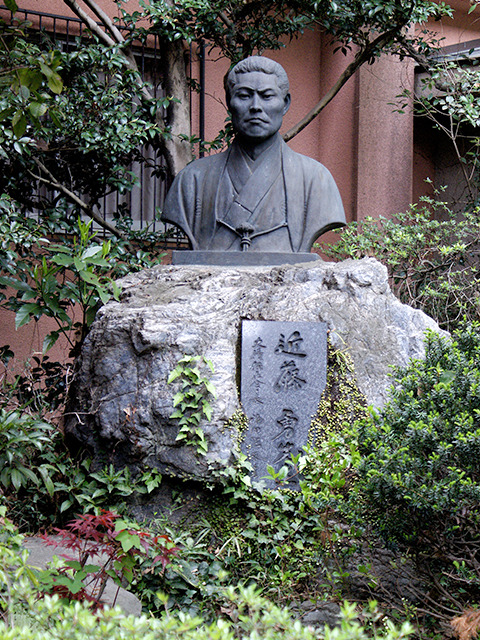
Kojima Museum
The reason why he chose Settsu resident Sekishin Okimitsu as his favorite sword
There are various theories as to why Sannan Keisuke chose this sword, but one of them focuses on the characters "Sekishin" (赤心) inscribed on the sword tang (nakago). Sekishin means "a true heart without lies".
However, when inscribed on a Japanese sword, another meaning is added. It means "loyalty to the emperor". It's believed to have originated from the "Sekishin Hokkoku-tou" (赤心報国刀), a sword used by Asami Keisai, a Confucian scholar in the mid-Edo period who preached "Kino Ushisou" (勤王思想) (The idea of being loyal to the emperor).
In fact, Sannan Keisuke is said to have been a man who was devoted to the ideology of "勤王" (loyalty to the Emperor) and often clashed with Kondo Isami and his followers. The Shinsengumi was formed by presenting a petition to the Aizu Clan, stating that the group would "Protect the Tencho and Taikiko, and expel the barbarians" (天朝並びに大樹公之御守護奉り、攘夷仕るべく候). "Tencho" refers to the Emperor and the Imperial Court, and "Taikiko" refers to the Shogun. However, as time went by, the Shinsengumi shifted away from the original purpose of the organization, moving away from the expulsion of the barbarians and transforming itself into a group that supported only the Shogunate.
Sannan Keisuke chose a sword named after Sekishin as his favorite sword. His refusal to participate in the Ikedaya Incident and the Kinmon Incident, as well as his decision to escape from serving the Shogunate, can be said to reveal his true face as an idealist who stubbornly upheld the principle of "loyalty to the emperor".
17 notes
·
View notes
Text
That moment when your sword hell fandom and your obsessive Sannan fandom combines and you spend all night dreaming up a Sekishin Okimitsu OC.
Devs please give us more Shinsengumi swords...!!!!
2 notes
·
View notes
Text

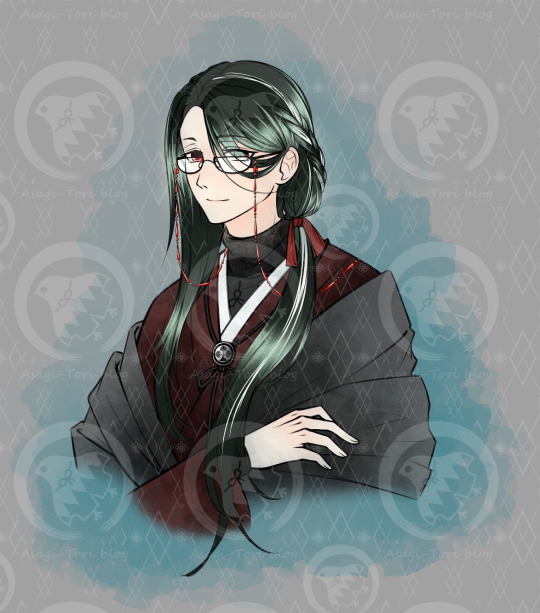


Introducing my Touken Ranbu OC Sekishin Okimitsu, Sannan/Yamanami Keisuke's Sword 💕
The hair was supposed to be black but a green tint would show when light hits it. I wanted the hair color to complement the color of the clothes. I'm not sure if I should change the green tint since people might think I'm copying Nikkari. (I might change it to a different color later)
I wanted him to have a red, black, white, and silver color palette. (I might change the colors a bit later since I'm not 100% happy with it) Fun Fact, Okimitsu has the kanji for red (赤) and heart (心) in his name. I wanted to incorporate this into his design.
I wanted him to look really pretty but also fragile. Since he's an Osaka sword like Saito's Kijinmaru. Swords made in Osaka were said to have been very beautiful but break very easily. Kondo even wrote in a letter saying that they were no good.
Also, I don't know if you can see it in the images above but I'm really proud of how the subtle coloring in the lips came out 💕

also, I just realized I forgot the hood on his haori arrgh
I had this idea that Sanan raised Okimitsu as a young sword spirit and thought of him like a son. Then he broke/died and this devastated Sanan 💔
#hakuoki#hakuouki#薄桜鬼#touken ranbu#刀剣乱舞#touken ranbu oc#sekishin okimitsu#赤心沖光#sannan keisuke#sanan keisuke#hakuouki x touken ranbu#my art#crossover
69 notes
·
View notes
Text

Sekishin Okimitsu: Look! Nagasone-san, I recreated the Ochimizu from Sanan-san's and Kodo-san's notes!
Nagasone Kotetsu: OH NO NOT AGAIN!!!
I'm experimenting with different coloring styles
I just realized I drew Okimitsu hair wrong but, whatever I'll fix it the next time I draw him
#hakuoki#hakuouki#薄桜鬼#touken ranbu#刀剣乱舞#touken ranbu oc#hakuouki x touken ranbu#sekishin okimitsu#赤心沖光#長曽祢虎徹#nagasone kotetsu#my art#crossover
16 notes
·
View notes
Text
Yamanami’s broken sword
January 20, 1864 (12th day of the 12th month, Bunkyu 3) on the day that Matsusuke Sukesuke visited the Kojima family. Below is Yamanami Keisuke's sword Sekishin Okimitsu



Inaccurate English Translation:
Item length: 3 shaku 8 sun 5 bu [116.7 cm], broken? 1 shaku 1 sun [33.3 cm] below the kissaki [tip] In front of the tsuba [sword guard]: 2 shaku 8 sun 5 bu [86.4 cm], ?? 1 shaku 1 sun 1 bu 5 rin [33.6 cm], mune? [back edge]: 3 bu 1 rin [0.9 cm] Sword chipped? in four places Banshu-juunin Sekishin Okimitsu
Shinsengumi Vice-Commander Yamanami Keisuke When roshi intruded the Iwaku Masuya and started an argument, he tried to intercept. After a few hits, his sword broke. Aizu publicly awarded him eight ryo once they learned about it.
Sword terminology Measurement conversions
Original Text of the second part (not accurate):
新選組局長山南敬助 岩木升屋江乱入浪士 討取候節打折候刀此時 会津公上為御賞美金八 (両)拌領りし候

More info: https://shima-syuji.com/2009/01/08/post-51/
1 note
·
View note
Text
Swords of the Shinsengumi
Kondo's Swords
Katana - Nagasone Kotetsu (長曾称虎徹) - 2'3"5
Minamoto Kiyomaro (源清麿)
Katana - Osumi no Kami Hiromitsu (大隅守廣光) - 2'5"5
Hijikata's Swords
Katana - Izumi no Kami Kanesada (和泉守兼定) 11 gen. - 2'8"
Katana (last sword) - Izumi no Kami Kanesada (和泉守兼定) 12 gen. - 2'3"1
Wakizashi - Izumi no Kami Kanesada (和泉守兼定)
Wakizashi - Horikawa Kunihiro (堀川国広) - 1'11"5
Katana - Echizen Yasutsugu (越前康継) - 2′3″5
Katana - Yamato no Kami Hidekuni (大和守源秀國) - 2′2″8
Okita's Swords
Katana - Kaga Kiyomitsu (加賀清光) - 2'4"4
Katana - Yamato no Kami Yasusada (大和守安定) - 2'4"6 ?
Katana (speculative) - Kikuichimonji Norimune (菊一文字則宗) - 2'4"2
Other Shinsengumi Swords
Shimada Kai's wakizashi: Osumi no Kami Hiromitsu (大隅守廣光) - 1'6
Yamanami's katana: Sekishin Okimitsu (赤心沖光) - 2'8"5
Nagakura Shinpachi's katana: Tegarayama Ujishige (手柄山氏繁)
Saito Hajime's katana: Kijinmaru Kunishige (鬼神丸国重)
Takeda Kanryusai's katana: Hitachi no Kami Kaneue (常陸守兼植)
Inoue Genzaburo's katana: Shirakawazumi Kanetsune (白川住兼常)
Todo Heisuke's katana: Kazusanosuke Kaneshige (上総介兼重)
Harada Sanosuke's katana: Kofuzumi Okitomo (江府住興友)
1 note
·
View note